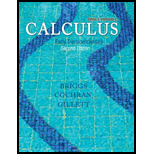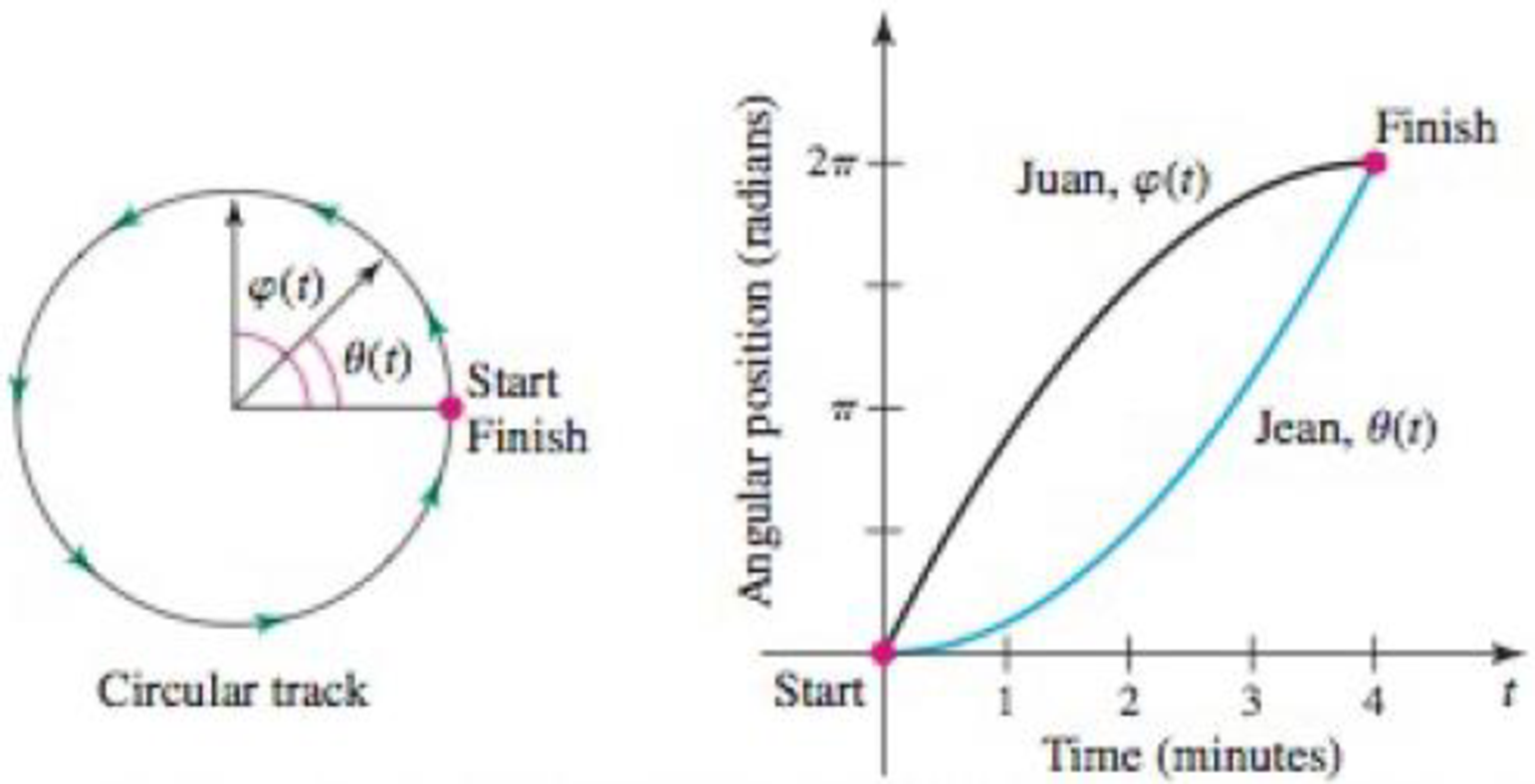
A race Jean and Juan run a one-lap race on a circular track. Their angular positions on the track during the race are given by the functions θ(t) and φ(t), respectively, where 0 ≤ t ≤ 4 and t is measured in minutes (see figure). These angles are measured in radians, where θ = φ = 0 represent the starting position and θ = φ = 2π represent the finish position. The angular velocities of the runners are θ′(t) and φ′(t).

- a. Compare in words the angular velocity of the two runners and the progress of the race.
- b. Which runner has the greater average angular velocity?
- c. Who wins the race?
- d. Jean’s position is given by θ(t) = πt2/8. What is her angular velocity at t = 2 and at what time is her angular velocity the greatest?
- e. Juan’s position is given by φ(t) = πt(8 − t)/8. What is his angular velocity at t = 2 and at what time is his angular velocity the greatest?
Want to see the full answer?
Check out a sample textbook solution
Chapter 3 Solutions
Single Variable Calculus: Early Transcendentals Plus MyLab Math with Pearson eText -- Access Card Package (2nd Edition) (Briggs/Cochran/Gillett Calculus 2e)
Additional Math Textbook Solutions
Thinking Mathematically (6th Edition)
Pre-Algebra Student Edition
A First Course in Probability (10th Edition)
Elementary Statistics: Picturing the World (7th Edition)
A Problem Solving Approach To Mathematics For Elementary School Teachers (13th Edition)
- 3. Mary needs to choose between two investments: One pays 5% compounded annually, and the other pays 4.9% compounded monthly. If she plans to invest $22,000 for 3 years, which investment should she choose? How much extra interest will she earn by making the better choice? For all word problems, your solution must be presented in a sentence in the context of the problem.arrow_forward4 πT14 Sin (X) 3 Sin(2x) e dx 1716 S (sinx + cosx) dxarrow_forwardLet g(x) = f(t) dt, where f is the function whose graph is shown. 3 y f(t) MA t (a) At what values of x do the local maximum and minimum values of g occur? Xmin = Xmin = Xmax = Xmax = (smaller x-value) (larger x-value) (smaller x-value) (larger x-value) (b) Where does g attain its absolute maximum value? x = (c) On what interval is g concave downward? (Enter your answer using interval notation.)arrow_forward
- 2. Graph the function f(x)=e* −1. Label three points on the graph (one should be the intercept) with corresponding ordered pairs (round to one decimal place) and label the asymptote with its equation. Write the domain and range of the function in interval notation. Make your graph big enough to see all important features. You may show the final graph only.arrow_forwardansewer both questions in a very detailed manner . thanks!arrow_forwardQuestion Considering the definition of f(x) below, find lim f(x). Select the correct answer below: -56 -44 ○ -35 ○ The limit does not exist. x+6 -2x² + 3x 2 if x-4 f(x) = -x2 -x-2 if -4x6 -x²+1 if x > 6arrow_forward
- Let g(x) = f(t) dt, where f is the function whose graph is shown. y 5 f 20 30 t (a) Evaluate g(x) for x = 0, 5, 10, 15, 20, 25, and 30. g(0) = g(5) = g(10) = g(15) =| g(20) = g(25) = g(30) = (b) Estimate g(35). (Use the midpoint to get the most precise estimate.) g(35) = (c) Where does g have a maximum and a minimum value? minimum x= maximum x=arrow_forwardQuestion Determine lim f(x) given the definition of f(x) below. (If the limit does not exist, enter DNE.) x+6+ -2x²+3x-2 f(x) -2x-1 if x-5 if -−5≤ x ≤ 6 3 if x 6arrow_forwardQuestion Given the following piecewise function, evaluate lim f(x). (If the limit does not exist, enter DNE.) x-3 Provide your answer below: x² + 3x 3 if x-3 f(x) -3 if -3x -2x²+2x-1 6 if x 6arrow_forward
- Question Given the following piecewise function, evaluate lim f(x). x→2 Select the correct answer below: -73 -24 -9 -12 The limit does not exist. 2x f(x) = -2x²-1 if -2x2 3x+2 if x 2arrow_forwardQuestion Given the following piecewise function, evaluate lim f(x). f(x) = x+1- -2x² - 2x 3x-2 2 x² +3 if x-2 if -2< x <1 if x 1 Select the correct answer below: ○ -4 ○ 1 ○ 4 The limit does not exist.arrow_forwardQuestion Given the following piecewise function, evaluate lim →1− f(x). Select the correct answer below: ○ 1 ○ 4 -4 The limit does not exist. -2x² - 2x x 1arrow_forward
- Algebra & Trigonometry with Analytic GeometryAlgebraISBN:9781133382119Author:SwokowskiPublisher:Cengage
 Trigonometry (MindTap Course List)TrigonometryISBN:9781337278461Author:Ron LarsonPublisher:Cengage Learning
Trigonometry (MindTap Course List)TrigonometryISBN:9781337278461Author:Ron LarsonPublisher:Cengage Learning Algebra and Trigonometry (MindTap Course List)AlgebraISBN:9781305071742Author:James Stewart, Lothar Redlin, Saleem WatsonPublisher:Cengage Learning
Algebra and Trigonometry (MindTap Course List)AlgebraISBN:9781305071742Author:James Stewart, Lothar Redlin, Saleem WatsonPublisher:Cengage Learning  Mathematics For Machine TechnologyAdvanced MathISBN:9781337798310Author:Peterson, John.Publisher:Cengage Learning,
Mathematics For Machine TechnologyAdvanced MathISBN:9781337798310Author:Peterson, John.Publisher:Cengage Learning, Trigonometry (MindTap Course List)TrigonometryISBN:9781305652224Author:Charles P. McKeague, Mark D. TurnerPublisher:Cengage Learning
Trigonometry (MindTap Course List)TrigonometryISBN:9781305652224Author:Charles P. McKeague, Mark D. TurnerPublisher:Cengage Learning Holt Mcdougal Larson Pre-algebra: Student Edition...AlgebraISBN:9780547587776Author:HOLT MCDOUGALPublisher:HOLT MCDOUGAL
Holt Mcdougal Larson Pre-algebra: Student Edition...AlgebraISBN:9780547587776Author:HOLT MCDOUGALPublisher:HOLT MCDOUGAL





